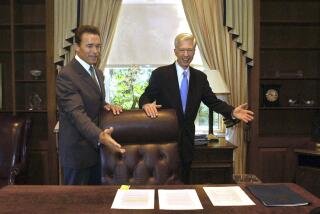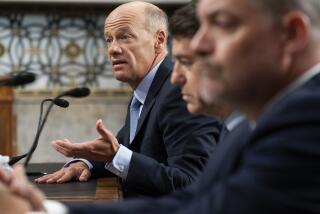Neel Kashkari’s stint running TARP inspired admiration, criticism
In 2008, when Treasury Secretary Henry M. Paulson needed someone to run the controversial bailout of the nation’s banks, he turned to a trusted and unflappable aide who had followed him from Goldman Sachs to Washington — Neel Kashkari.
“We had other people who were senior and more experienced,” Paulson recalled in an interview. “But I didn’t see anyone else on my team who was willing to step up and be accountable and take the responsibility.”
Five-and-a-half years later, seeking the Republican nomination for California governor, Kashkari has made his stint running the Troubled Asset Relief Program, better known as TARP, a central element of his campaign.
It’s an unconventional choice. TARP, as former Rep. Barney Frank (D-Mass.) later said, was “the most highly successful, wildly unpopular thing the federal government has done in my memory.”
Kashkari hopes voters will focus on the program’s success in combating the financial crisis, not the policy’s unpopularity. His six months at TARP demonstrated an ability to run a complex program that is widely acknowledged to have helped stabilize the economy, he says.
“It was executed spectacularly,” Kashkari said in an interview. “I take pride in what we did.”
Interviews with Paulson and other key officials and an examination of the record confirm Kashkari’s crucial role in conceiving, setting up and administering TARP during its most significant period.
The record reveals some less flattering elements as well.
Watchdog agencies complained Kashkari was overly secretive and deferential to the big banks. And at least some of the credit for recovering TARP funds — the Treasury Department has netted nearly $15 billion more than was spent — goes to Obama administration officials who ran the program after Kashkari.
Moreover, the record shows that some of the most important decisions — including the pivotal one to inject money directly into banks — were made above Kashkari’s pay grade.
As Paulson made clear, “I was there making the major decisions on policy.”
Still, Kashkari “was the man in terms of running it, managing it, hiring the people, making sure the programs were executed, I would say, flawlessly,” Paulson said. “He exceeded my expectations.”
In an interview, Kashkari was careful to give Paulson credit for the high-level decisions.
“I don’t want to exaggerate my role,” Kashkari said. “He was the Treasury secretary. I worked for him.”
On the campaign trail, Kashkari doesn’t delve into the details. He tells voters he was one of the government officials trying to stem the crisis and that he ran TARP.
“I helped design TARP. I ran TARP under two presidents,” he said in the interview. “I own TARP.”
Kashkari’s ambition and willingness to take risks were evident from his first dealings with Paulson, who had been the chief executive at Goldman Sachs Group Inc., the giant Wall Street investment bank, before President George W. Bush tapped him in 2006 to run the Treasury Department.
Paulson and Kashkari, who led the firm’s information technology security investment banking practice in San Francisco, had met only once. But Kashkari called Paulson and said he wanted to join him in Washington to learn how government worked. Paulson was impressed and hired him as a senior advisor.
They joined a long line of Goldman Sachs executives who had made the move to Washington over the years, leading to the firm’s moniker of Government Sachs.
Within a year, Treasury officials were grappling with a crash in the housing market. As real estate prices fell, banks that had invested heavily in bonds backed by bundles of mortgages began to rack up huge losses.
Paulson assigned Kashkari and another Treasury official, Phillip Swagel, to develop a contingency plan.
“What if all the banks fail or if they’re on the verge of failing?” Kashkari said they were told to address. “What do we do?”
They solicited input from such experts as former Federal Reserve Chairman Alan Greenspan and billionaire investor Warren Buffett, then produced a 10-page memo they called the “ ‘Break the Glass’ Bank Recapitalization Plan,” equating it to a fire emergency box.
The plan outlined options for a severe financial crisis. The focus was a $500-billion program in which the Treasury Department would buy toxic mortgage-backed assets from banks.
Kashkari said he thought at the time there was no more than a 5% chance the plan would be needed.
“We hated the notion of it,” but kept it on the shelf just in case, he said.
Less than six months later, it was time to break the glass.
Fannie Mae and Freddie Mac, the mortgage finance firms, teetered near collapse, and the government seized control of them. Lehman Bros. filed for bankruptcy. And the Federal Reserve took the extraordinary step of rescuing insurance giant American International Group.
As terrified bankers stopped lending money, the global financial system began to seize up. Paulson and Bernanke went to Congress to ask for $700 billion to buy troubled assets.
Kashkari was among a small group of aides Paulson took to Capitol Hill to negotiate the terms. Three days after the legislation passed, Paulson named Kashkari to run TARP, instantly vaulting his unknown 35-year-old aide into the spotlight as the person the media dubbed “the $700-billion man.”
“I had no idea what it meant, what a big deal it would turn out to be,” Kashkari said.
With his bald head and intense gaze, Kashkari became the face of TARP. His first public appearance came a week later at a banking conference in an expensive Washington hotel. Kashkari recalled sitting in the lobby, writing notes for his speech, when he was surrounded by TV cameras.
In the speech, which was carried live on C-SPAN and CNBC, Kashkari noted the new law gave the Treasury secretary “broad and flexible authority” to purchase assets as well as “any other financial instrument” needed to stabilize the financial system.
It was a hint of a dramatic policy change Paulson would make official the next day: The Treasury Department largely was abandoning the strategy Kashkari had been working on.
Rather than buy bank assets that had dramatically lost value, the government would pump $250 billion directly into the banks — “Alternative D” on the last page of the “Break the Glass” memo.
The shift was Paulson’s decision, but Kashkari was among the few people he consulted, the former Treasury secretary said.
“He was right there. He agreed with all of us on switching from buying assets to capital injections,” Paulson said.
The move was crucial, said Mark Zandi, chief economist at Moody’s Analytics and coauthor of a 2010 study on how the crisis and recession were ended. “To put together asset purchases would have taken time, and they didn’t have the time,” he said.
Kashkari assembled a staff of 140 people, and his office distributed about $400 billion over the six months he ran TARP, which included the first few months of Obama’s administration. “We knew where every single penny went … so we could ultimately get it all back,” Kashkari said.
Said former Treasury official Swagel, “The thing where Neel gets 120% of the credit is the execution, making it work quickly.”
TARP has been controversial from the start because it helped create an era of banks being considered “too big to fail” and because it bailed out Wall Street, but not most of the homeowners facing foreclosure.
In addition to those broad policy issues, Kashkari clashed with the program’s overseers, including Neil Barofsky, the special inspector general for TARP, about whether banks should report how they were using the money so taxpayers could see if they were lending it.
Kashkari said he opposed forcing banks to lend because bad loans were what had caused the crisis.
“It was not a lending-support program,” Kashkari said in the interview. “It was a prevent-the-financial-collapse program.”
Barofsky, in his 2012 book “Bailout,” called Kashkari “combative, not always forthcoming, and excessively deferential to Wall Street.” But Barofsky added that he found Kashkari generally straightforward and had “a grudging respect for him.”
Elizabeth Warren, who chaired a TARP oversight panel at the time and is now a Democratic senator from Massachusetts, was less complimentary. In her new book, “A Fighting Chance,” she accused Kashkari of misleading her at their first meeting in November 2008.
Kashkari told her he didn’t expect any additional bailout money for big banks, Warren wrote. Less than two days later, Citigroup received a second large injection of TARP cash.
In an interview, Kashkari said Warren’s charge was “preposterous.”
But over time, Kashkari earned respect from many Democrats, even if they didn’t agree with TARP policies.
Former Rep. Dennis J. Kucinich (D-Ohio), who chaired one of the congressional subcommittees overseeing the program, voted against TARP because he opposed bailing out the banks. He wanted more oversight into how the money was spent.
He called Kashkari “one of the smarter people” he met in Washington.
“In my dealings with him I found him to be bright, straightforward, clear-thinking,” Kucinich recalled. “But,” he added, on TARP, “he wasn’t the boss.”
More to Read
Start your day right
Sign up for Essential California for news, features and recommendations from the L.A. Times and beyond in your inbox six days a week.
You may occasionally receive promotional content from the Los Angeles Times.







